Articles
From «Popular Science», September 1948
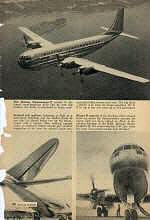
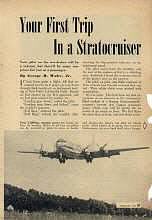

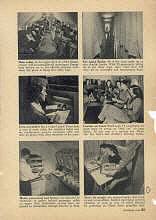
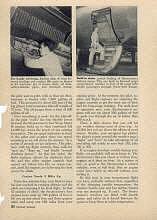
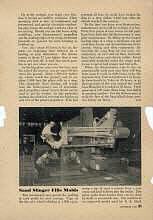
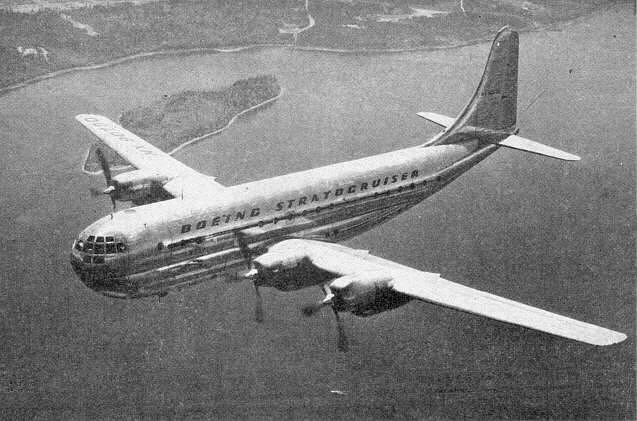 |
| The Boeing Stratocruiser cousin to the famed atom-bombing B-29 and its new big brother, the B-50, is scheduled to begin commercial air-line service next year. The big plan - 110 ft. 4 in. long, it wings spreading 141 ft. 3 in. tip to tip - can carry up to 114 passengers. |
| Vertical tail surface, towering as high as a three-story building, can be folded down to one side (as shown below) to let the Stratocruiser into a hangar. Men walking upright under an outboard engine nacelle give another suggestion of the new sky queen's great size. |
Figure 8 contour of the fuselage, when viewed head on, shows the Stratocruiser's ancestry. Its upper deck has been added, in effect, to the circular fuselage of the B-29. Boeing's Stratofreighter, the cargo-carrying C-97, has much the same cross-section as the new air liner. |
 |
 |
Your First Trip in a Stratocruiser
Your pilot on the two-decker will be a veteran, but there'll be many surprises for you as a passenger.
By George H. Waltz, Jr.
It had been quite a flight. All that remained was for us to grope our way down through thick weather to an instrument landing at New York's La Guardia Field. Rough air had messed up our first approach, and we had gone around for another try.
"Landing gear downs," call the pilot.
"Landing gear down and locked," cam the co-pilot's response.
"Full flaps," ordered the pilot.
"Full flaps," echoed the co-pilot, after checking the flap-position indicator on the instrument panel.
The pilot eased back the throttles, and the roar of the engines settled to w whistling purr. Suddenly I heard the welcome screech of the plane's tires on the runway.
The pilot, co-pilot, and flight engineer at their controls hat literally sweated that one out. Their white shirts were spotted with perspiration.
So was mine. This had been my first experience as an observer in the instrument-filled cockpit of a Boeing Stratocruiser - aviation's newest and biggest passenger plane, which soon will be plying the air routes of six major air lines. We had flown for more than an hour, and just about everything
| Four 3,500-hp. engines power the luxury air liner. In landing, blades of all four propellers can be reversed in pitch to serve as brakes and shorten the plans run after its wheels touch. With blades of its props thus reversed, Stratocruiser can even back itself into a hangar. |
 |
 |
 |
| Stratocruiser cockpit houses some 600 controls and indicators. Seated here are pilot (left), co-pilot (right), flight engineer (foreground). Plane carries navigator, radio operator. |
Flight simulator for training Stratocruiser crews is duplicate of PAA's cockpit. Instructor at "trouble box" in foreground creates flying problems and checks the trainees' responses. |
had happened: bad weather, ice on the wings, an engine failure, radio troubles. And we had completed the flight successfully without ever leaving the ground
We had been "flying" the amazing new electronic flight simulator built by Curtiss-Wright. It is used by Pan Americans Airways to train the crews who will fly a PAA fleet of 20 Stratocruisers.
The flight simulator, which costs $250'000, is an exact duplicate of the Stratocruiser's cockpit. Thanks to an ingenious electronic brain, its instruments and flight controls function just as they do in the actual airplane. Seated in the simulator, a pilot can go through any maneuver he normally would execute in the air - plus a good many he wouldn't dare to try if actually flying the $1'500'000 aircraft.
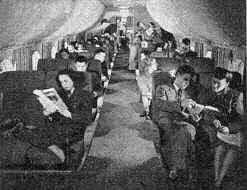 |
 |
| Main Cabin, on the upper deck of a PAA Stratocruiser, will accommodate 61 passengers. Pumps keep interior air at low-altitude pressure even when the plane is flying five miles high. |
For night flights 36 of the seats make up as nine double berths. With 25 passengers sitting up in the other seats, main cabin thus will carry 43 on overnight and transoceanic hops. |
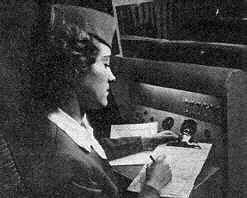 |
 |
| Even stewardess has a control panel. From desk at rear of main cabin she regulates lights and air conditioning, answers passenger calls, and talks by phone with other members of the crew. |
Lounge on lower level seats 14 passenger on short trips, or serves as "club car" on long flights. At one end is a serving bar. Plane also has men's and women's dressing rooms. |
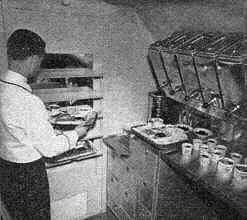 |
 |
| Meals, pre cooked and frozen, are reheated by electricity in galley behind passenger cabin on upper deck. Individual serving trays are passed to stewardess through louvers in door. |
Trays fit snugly into rimmed tables that hook to seats at mealtime. Rubber mountings prevent vibrations of seats in area of cabin affected by pulsating air blast from propeller tips. |
Trouble Made to Order
By twirling dials and flipping switches, a flight instructor, hidden form the pilot and his crew, can make the simulator duplicate just about any kind of lying problem. Then it is up to the flight crew to correct or meet the trouble and complete the flight. Even engine noises and landing sounds are faithfully reproduced. In fact, no greater tribute could be paid to the simulator's realism than the spots of perspiration on the shirts of oldtime pilots when they emerge after a "flight" -- even though the earth-bound cockpit is air conditioned.
After my first "flight" in the simulator, I found out more about the Stratocruiser from PAA and Boeing pilots and engineers. I was particularly interested in the new plane because, during the war, I had spent quite a bit of time in the B-29. In fact, I wrote the AAF's pilot-training manual for it. And I knew that Boeing's latest sky queen was development of than atom-bomb carrier.
When an airplane just naturally wants to do what the pilot would have it do, flyers call it a "pilot's airplane." The Stratocruiser, I learned, is not only very much a pilot's airplane, but a passenger's airplane and a maintenance man's airplane as well.
Let's climb aboard a Stratocruiser for a transoceanic flight. Inside its main passenger cabin, 74 feet long, you take a softly cushioned seat that is the result of more than 100,000 man-hours of research and design. It automatically fits itself to the contours of your body whether you are long or short, fat or lean.
Unlike most flights that you have taken before, this will be no "sit-down" trip. The Stratocruiser is a double-decked airplane. If you get tired of sitting, a centrally located spiral staircase will lead you below to a spacious lounge much like the club car on the fanciest transcontinental train.
In flight, you will breathe air that has been filtered, deodorized, and warmed or cooled according to the need. Up to 15,000 ft., the air pressure in the cabin will be no less than it was at sea level. Even at 25,000 ft., the altitude at which we will make most of our trip, the cabin pressure will never fall below the ordinarily found at 5,500 ft. Your ears won't pop or your nose plug up.
Now that the last passenger is aboard and they are taxiing our ship out for take-off, let's go up front and have a look at the cockpit and flight deck. A glance at the fuel gauges at the flight engineer's position, just behind the pilot and co-pilot, tells us that our Stratocruiser is loaded with 7,630 gallons of fuel. This accounts for about 22.5 tons of the big plane's total maximum take-off weight of 70 tons. The oil gauges show a total of 200 gallons of oil.
Now everything is ready for the take-off. As the pilot "walks" his four throttle levers forward, the Stratocruiser's four Wasp Major (T) engines build up to their combined full 14,000 hp. — twice the power of any existing locomotive. The air-speed indicators in front of the pilot and co-pilot show our speed mounting as we roll down their runway. In a matter of seconds we are airborne. The pilot, busy with his flight controls, then calls for "gear up," "flaps up" and finally "normal climbing power." At this last order, the flight engineer adjusts his duplicate throttles and the other engine controls that spread out before him like an organ console, until the engines are delivering the best power for climb.
 |
 |
| For handy servicing,leading edge of wing between fuselage and engines lifts open on hinges to let mechanic get at heater ducts, oil lines, carbon-dioxide pipes, and electrical wiring |
Built-in stairs permit loading of Stratocruiser without ramps. This one leads to forward cargo compartment. Another in door of aft cargo hold admits passengers through lower-deck lounge. |
Cruises Nearly 5 Miles up
Forty-five minutes later your Stratocruiser has just reached its cruising altitude and the pilots are trimming it for level flight. In that 45 minutes of climb, the Stratocruiser's four engines have used up 700 gallons of fuel to lift you up just about four and three-quarter miles and carry you 182 miles from your starting point. At the moment, the pilot co-pilot, and flight engineer are adjusting the engine controls to get the most out of their fuel for long-range cruising. For each hour of operation now, your Stratocruiser's engines will use up about 530 gallons of fuel to push you through the air at better than 300 m.p.h.
There is little chance that you will hit any weather during most of your trip. At 25,000 feet you are above the effects of most storms. Besides, your navigator has plotted the plane's course around the weather map's "highs" and "lows" to take advantage of all prevailing tail winds to save fuel (PS, July '46, p. 93).
In an engine develops trouble during your flight, you probably will never know it. The Stratocruiser flies just about as well on three engines as it does on four. As a matter of fact, so good is the Stratocuriser0s natural stability, even at full load, that an engine could have filed on take-off without you felling it.
By this time in your transoceanic flight you have probably noticed that, regardless of the changing outside temperature, the window beside your seat has neither frosted over not steamed up. It can't. The Stratocruiser's windows are fitted with double pane, and cabin air is forced between the panes to keep them at cabin temperature.
Up in the cockpit, your flight crew likewise is having no visibility problems. Their operating deck is also air-conditioned and pressurized, and special electricity-conducting glass keeps the cockpit windows clear of ice and fog. Should you run into heavy icing conditions, your Stratocruiser's propellers and the leading edges of its wings are heated internally to prevent ice from forming or building up.
Now, after about 10 hours in the air, the pilots are beginning their letdown for a landing at your destination. The Stratocruiser is about 17 tons lighter than it was when you took off: it took that much gasoline to get you where your are.
As the big plane soars over the trees near the end of the runway, you are some 50 feet above the ground. About 1,300 feet farther the wheels touch the ground, and in another 1,800 feet the plane rolls to a stop. This amazingly short landing roll results from the Stratocruiser's use of reversible pitch propellers whose reverse thrust can be used to aid the bakes. In this particular landing, the pilot had reversed the blades on only two of the plane's propellers. If he had reversed all four, he could have braked his ship to a stop within 1,230 feet after its wheels touched the runway.
By the time you leave your Stratocruiser, maintenance crews will be working over her. Forty-four points of easy access to vital parts have been built into the Stratocruiser to simplify maintenance. By lifting up the hinged leading edge of a wing, a mechanic can get at oil lines, heater and air-conditioning ducts, electric wiring, and other equipment. By lowering the wing flaps he can work, unobstructed, on fuel and oil lines, hydraulic removable manholes under the wings make it easy to get at fuel pumps and fuel cells.
When the Stratocruiser take to the air commercially early next year they will hop form coast to coast in eight hours, make the trip form New York to London in 11.5 hours, or go three-quarters of the way around the world from Shanghai to London in 38 hours. Their passengers will make those long, fast flights in amazing comfort. For the Stratocruiser is truly the first of the long-talked-about post-war luxury air liners.

























